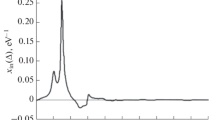Abstract
The features of the electron-probe energy-dispersive spectra of several powder materials are studied. Comparing the experimental results with published data, it is established that the effect of a difference in absorption is the main factor that affects the results of quantitative analysis. To describe the peculiarities of attenuation of the intensity of X-ray photons in powders, a theoretical absorption model is proposed and tested. In the described model, the surface of a sample is considered to be a combination of a large number of randomly oriented planes. The experimental data and simulation results are compared by analyzing the ratio of diagnostic-line intensities. The proposed model of attenuation of the characteristic radiation intensity in the powders agrees well with the experimental data. A mathematical method for taking into account the surface roughness can be used in computer algorithms for simulating the characteristic X-ray radiation and can be included in software for electron-probe analysis as an additional corrector in calculation of the elemental composition of the powder materials.







Similar content being viewed by others
REFERENCES
D. E. Newbury and N. W. M. Ritchie, J. Mater. Sci. 50 (2), 493 (2015). https://doi.org/10.1007/s10853-014-8685-2
D. E. Newbury and N. W. M. Ritchie, Scanning 35 (3), 141 (2013). https://doi.org/10.1002/sca.21041
Yu. G. Lavrent’ev, N. S. Karmanov, and L. V. Usova, Geol. Geofiz. 56 (8), 1473 (2015). https://doi.org/10.15372/GiG20150806
J. I. Goldstein, D. E. Newbury, J. R. Michael, et al., Scanning Electron Microscopy and X-Ray Microanalysis (Springer, New York, 2018). https://doi.org/10.1007/978-1-4939-6676-9
D. E. Newbury and N. W. M. Ritchie, Microsc. Microanal. 19 (S2), 1244 (2013). https://doi.org/10.1017/S1431927613008210
Handbook of X-Ray Spectrometry, Ed. by R. E. Van Grieken and A. A. Markowicz, 2nd ed. (CRC, New York, 2001).
D. E. Newbury, Scanning 26, 103 (2004). https://doi.org/10.1002/sca.4950260302
J. T. Armstrong and P. R. Buseck, Anal. Chem. 47 (13), 2178 (1975). https://doi.org/10.1021/ac60363a033
J. T. Armstrong and P. R. Buseck, X-Ray Spectrosc. 14 (4), 172 (1985). https://doi.org/10.1002/xrs.1300140408
J. T. Armstrong, in Electron Probe Quantification, Ed. by K. J. F. Heinrich and D. E. Newbury (Plenum, New York, 1991), p. 261. https://doi.org/10.1007/978-1-4899-2617-315
R. Gauvin, P. Hovington, and D. Drouin, Scanning 17 (4), 202 (1995). https://doi.org/10.1002/sca.4950170401
H. M. Storms, K. H. Janssens, S. B. Torok, and R. E. Van Grieken, X-Ray Spectrosc. 18, 45 (1989). https://doi.org/10.1002/xrs.1300180203
A. Paoletti, B. M. Bruni, A. Gianfagna, et al., Microsc. Microanal. 12 (5), 710 (2011). https://doi.org/10.1017/S1431927611000432
N. W. M. Ritchie, Microsc. Microanal. 16 (3), 248 (2010). https://doi.org/10.1017/S1431927610000243
J. Trincavelli and R. E. Van Grieken, X-Ray Spectrosc. 23, 254 (1994). https://doi.org/10.1002/xrs.1300230605
J. L. Labar and S. B. A. Torok, X-Ray Spectrosc. 21, 183 (1992). https://doi.org/10.1002/xrs.1300210407
P. Hovington, M. Lagace, and L. Rodrigue, Microsc. Microanal. 8 (S2), 1472 (2002). https://doi.org/10.1017.S1431927602103990
J. A. Small, J. Res. Natl. Inst. Stand. Technol. 107 (6), 555 (2002).
D. Drouin, A. R. Couture, D. Joly, et al., Scanning 29 (3), 92 (2007). https://doi.org/10.1002/sca.20000
D. Drouin, P. Hovington, and R. Gauvin, Scanning 19 (1), 20 (1997). https://doi.org/10.1002/sca.4950190103
P. Hovington, D. Drouin, and R. Gauvin, Scanning 19 (1), 1 (1997). https://doi.org/10.1002/sca.4950190101
P. Hovington, D. Drouin, R. Gauvin, et al., Scanning 19 (1), 29 (1997). https://doi.org/10.1002/sca.4950190104
ACKNOWLEDGMENTS
We are grateful to S. V. Vasil’ev, senior research associate of Valiev Institute of Physics and Technology, Yaroslavl Branch, Russian Academy of Sciences, for his assistance in the mathematical calculations.
Funding
Analytical equipment of the Center for Collective Use Diagnostics of Microstructures and Nanostructures was used in the study. The study was supported by the Ministry of Education and Science of the Russian Federation within the framework of State assignment to Valiev Institute of Physics and Technology, Russian Academy of Sciences, on topic no. 0066-2019-0003.
Author information
Authors and Affiliations
Corresponding author
Additional information
Translated by O. Kadkin
Rights and permissions
About this article
Cite this article
Pukhov, D.E., Lapteva, A.A. Taking into Account the Surface Roughness in the Electron-Probe Energy-Dispersive Analysis of Powder Materials. J. Surf. Investig. 14, 889–898 (2020). https://doi.org/10.1134/S1027451020050146
Received:
Revised:
Accepted:
Published:
Issue Date:
DOI: https://doi.org/10.1134/S1027451020050146




